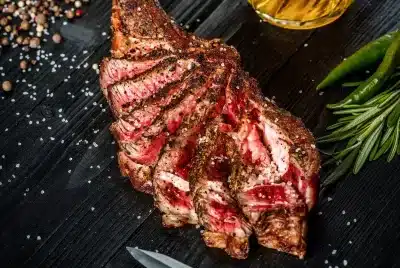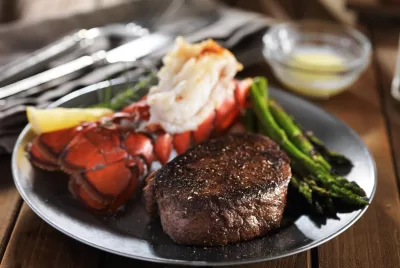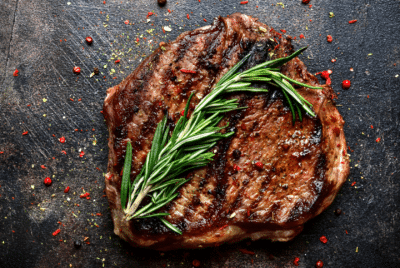What Are the Different Types of Steak?
Steak, the revered monarch of meats, has held a place in traditions for generations. Whether enjoyed at a backyard gathering or a fancy steakhouse, the charm of a cooked steak, whether grilled or pan-seared, is simply irresistible. The term “steak” encompasses a variety of cuts, each offering flavors, textures, and preparation methods. Let’s delve into the world of steak options.
In this piece, we’ll delve into the realm of steaks, exploring their types, characteristics, and the best ways to relish them.
Table of Contents
- 1 Understanding Beef Cuts: A Basic Guide
- 1.1 Tenderloin: The Aristocrat of Steaks
- 1.2 Ribeye: The Flavor Powerhouse
- 1.3 Strip Steak: The Goldilocks of Steaks
- 1.4 Flank Steak: A Grillmasters Go-To
- 1.5 Skirt Steak: Bursting with Flavor
- 1.6 Hanger Steak: A Hidden Gem
- 1.7 Flat Iron Steak: The Underappreciated Star
- 1.8 T-Bone and Porterhouse: The King of Steaks
- 1.9 Tri-Tip Steak: A Californian Favorite
- 1.10 Chuck Eye Steak: A Deliciously Affordable Option
- 1.11 Denver Steak: A Hidden Treasure
- 2 Tomahawk Steak: The Showstopper
- 3 Conclusion
Understanding Beef Cuts: A Basic Guide
Before delving into the steak varieties, it’s crucial to grasp the fundamental structure of a cow. Different beef cuts are sourced from muscle groups in the animal’s anatomy; each cut boasts its own texture and taste profile. The tenderness of a steak is influenced by factors such as tissue and muscle activity during the cow’s lifespan.
The coveted cuts originate from areas like the loin and rib regions where muscles undergo strain leading to tenderness. Conversely, cuts from areas such as chuck, round, and brisket tend to be tougher due to tissue content and more frequent muscle use.
Tenderloin: The Aristocrat of Steaks
When it comes to steak, few cuts can compare to the tenderness and sophistication of the tenderloin. Also referred to as filet mignon, this cut originates from the psoas muscle located along the spine, which is minimally used by the animal. Consequently, the tenderloin boasts tenderness and leanness, making it a beloved choice among steak aficionados.
Typically cooked by grilling, broiling, or pan-searing, the tenderloin allows its delicate flavor to shine through. Because of its leanness, it’s advisable to cook the tenderloin no more than medium-rare to prevent it from becoming dry. While it may not offer the flavor of some cuts, the unmatched tenderness and buttery texture of tenderloin make it a luxurious treat.
Ribeye: The Flavor Powerhouse
For those craving a steak with flavor and a succulent texture, look no further than ribeye. Also known as Delmonico or Cowboy Steak, ribeye is sliced from the rib section of the animal, where muscles are generously marbled with fat.
The marbling in ribeye—the distribution of fat throughout—is what gives it its taste and tenderness.
When cooked right, the fat. Flavors the meat from the inside, resulting in a delicious and satisfying steak-eating experience that is both juicy and flavorful.
Ribeye steaks are best prepared using heat cooking methods such as grilling or searing in a cast iron skillet. This allows for a crispy crust while keeping the meat tender and moist. Whether seasoned with salt and pepper or enhanced with a compound butter, ribeye steaks are always a hit with diners.
Strip Steak: The Goldilocks of Steaks
The strip steak, also known as the New York strip or Kansas City strip, is like the Goldilocks of steaks. Not too tender. It strikes a balance between flavor and texture due to its marbling from the short loin area. This marbling gives it flavor and juiciness.
With its meaty taste and moderate tenderness, the strip steak is loved by steak enthusiasts. It can be cooked using methods like grilling, broiling, or pan-searing.
In terms of preparation, the strip steak is versatile. It can be enjoyed simply seasoned with salt and pepper or paired with compound butter, sauces or even stuffed with ingredients like cheese or mushrooms, for added flavor.
Flank Steak: A Grillmasters Go-To
For those looking for a budget-friendly option, flank steak is a good choice. This cut, taken from the cow’s belly muscles, is known for its taste and unique texture.
While it may not be as tender, as premium-cut flank steak makes up for it with its flavor and ability to absorb marinades. Seasonings well. Its leanness also makes it a healthier choice for those mindful of their fat intake.
To truly savor a flank steak, preparation and cooking techniques are key. It is recommended to marinate the meat for hours to tenderize it and enhance its flavor profile. When it comes to cooking, grilling or broiling at high heat is ideal to achieve a sear on the outside while keeping the inside juicy and tender.
Slicing the flank steak against the grain before serving can further enhance its tenderness. Make it easier to eat. Whether you prefer marinating or using a rub, flank steak offers versatility and delicious flavor.
Skirt Steak: Bursting with Flavor
The plate section of the cow skirt steak is renowned for its intense flavor profile.
Like flank steak, skirt steak is known for being a bit tough because of its high muscle fiber and connective tissue content. Despite its lack of tenderness, skirt steak makes up for it with its flavor, which stands out. Its coarse texture and strong beef taste make it a top choice, for those who enjoy bold, meaty flavors.
Similar to flank steak, skirt steak benefits from marinating or dry rubbing to soften it up. Add flavor to it. It is recommended to cook it over high heat, like grilling or searing, in a cast iron pan to get char on the outside while keeping the inside juicy and tender.
Skirt steak is often sliced against the grain. Used in dishes like fajitas, and stir-fries, or as an ingredient in hearty salads. Its robust flavor pairs perfectly with marinades, sauces, and side dishes, making it a versatile and tasty option for any meal.
Hanger Steak: A Hidden Gem
Known as the “butcher’s steak” or the “hanging tenderloin ” hanger steak is a cut loved by those who appreciate steaks but may not be as well known. It comes from the plate area of the cow, near the kidneys. Is valued for its flavor and tenderness.
Despite its tenderness, hanger steak has a texture because it contains a high amount of muscle fibers. This distinctive texture, combined with its flavor, appeals to those who appreciate a steak with personality and complexity.
To cook the steak properly, it is best to use high-heat cooking methods such as grilling or pan searing due to its leanness and tenderness. Care should be taken not to overcook it, as it may toughen and dry out if cooked beyond rare.
Although not readily found as cuts, the hanger steak is a hidden treasure for those in the know. Its bold flavor and unique texture set it apart as a choice for anyone looking for a steak-eating experience. If you’re curious about exploring different types of steaks, let’s delve into that.
Flat Iron Steak: The Underappreciated Star
The iron steak, also known as the blade steak, is a relatively new cut that has gained popularity in recent years. Originating from the cow’s shoulder area, this steak was previously considered tough and unappealing. However, due to advancements in butchering techniques, flat iron has transformed into a tender and flavorsome option.
The flat iron steak stands out for its elongated shape and abundant marbling, which give it texture and a flavorful taste. Although it may not match the tenderness of tenderloin or the richness of ribeye, this cut strikes a balance between the two, offering versatility and affordability.
When preparing iron steak, you have cooking options like grilling, broiling, or pan searing. It’s crucial to cook it to achieve the desired level of doneness; otherwise, overcooking can result in toughness and dryness.
Whether you choose to marinate it, season it with spices, or simply use salt and pepper, the flat iron steak remains a tasty choice for budget steak enthusiasts or those looking to explore beyond traditional cuts.
T-Bone and Porterhouse: The King of Steaks
A discussion on types of steaks would be incomplete without highlighting T-bone and Porterhouse steaks. These cuts are considered royalty in the world of steaks as they combine the features of both strip loins.
The T-bone steak derives its name from its T-shaped bone that separates the tenderloin from the strip loin. On the other hand, the porterhouse is essentially a version of a T-bone steak.
When it comes to steak, there’s a lot to love about the T-bone and Porterhouse cuts.
Both offer that mix of tenderness from the rich flavor of the strip loin. These steaks are a treat for your taste buds with their melt-in-your-mouth texture and delicious flavors.
Cooking these steaks right takes some skill because each muscle has its own level of tenderness and may need slightly different cooking times. Grilling, broiling, or pan-searing are methods to get that sear on the outside while keeping the inside just how you like it.
Whether you’re a fan of a T bone or prefer a fancy Porterhouse with compound butter or red wine reduction, these steaks are sure to wow any steak enthusiast.
Tri-Tip Steak: A Californian Favorite
Coming from California, the tip steak has become well-loved for its great taste, affordability, and versatility. This cut from the bottom sirloin area stands out with its triangular shape and nice marbling that makes it perfect for grilling or smoking. The tri-tip steak is famous for its taste and tender, juicy texture when prepared correctly. Its distinct shape and marbling help it form a crust on the surface while staying soft and moist inside.
This particular cut is highly regarded in California, where it is commonly seasoned with Santa Maria-style rubs or marinades before being grilled or smoked to perfection. The tri-tip adaptability also allows it to be thinly sliced for fajitas or cubed for kebabs or stir-fries.
Whether you’re hosting a backyard barbecue or simply seeking a flavorful steak choice, the tri-tip should definitely be on your list if you love steak. Its unique flavor profile and versatility truly set it apart in the realm of steaks.
Chuck Eye Steak: A Deliciously Affordable Option
For those looking for a wallet-friendly alternative to pricier cuts, the chuck eye steak is a pick. This cut hails from the chuck area, commonly known as the shoulder, which is often overshadowed by its counterparts.
Despite its beginnings, the chuck eye steak delivers a beefy flavor and surprisingly tender texture when cooked properly.
The marbling and positioning close, to the ribeye region contribute to its flavor and juiciness.
One great thing about the Chuck Eye steak is its affordability! It’s a budget option for those looking to save money or cater to groups. It’s a cut that can be prepared using cooking methods like grilling, broiling, and braising.
When cooked properly, the chuck eye steak can be a treat. It provides a steak-eating experience without costing a fortune. Whether you choose to marinate it for flavor or keep it simple with salt and pepper, this underappreciated cut is bound to leave a good impression.
Denver Steak: A Hidden Treasure
The Denver steak (also known as the Denver cut or Zabuton steak) is a discovery in the world of steaks. Despite its introduction, it has quickly garnered a following, among steak lovers. This cut comes from the chuck area of the cow, from the serratus ventralis muscle.
What makes the Denver steak stand out is its blend of tenderness and flavor. Despite originating from the chuck area, this steak offers tender meat.
This particular cut of meat does not offer a burst of flavor. It also boasts a rich, beefy taste that can rival some of the pricier cuts available. Its intricate marbling and proximity to the ribeye area contribute significantly to its depth of flavor and succulence.
When it comes to preparing the Denver steak, it is recommended to use heat cooking methods such as grilling or pan searing. This ensures that it develops a crust while retaining its tenderness and juiciness. Seasoning options range from salt and pepper to elaborate choices like compound butter, sauces, or marinades, all intended to elevate its taste profile.
Although less known in circles, the Denver steak is steadily gathering a following. Many aficionados appreciate its blend of tenderness, flavor profile and affordability. If you haven’t yet had the pleasure of savoring this hidden gem, it’s certainly worth seeking out.
Tomahawk Steak: The Showstopper
Now shifting focus to the Tomahawk steak—a spectacle for those in search of a dining experience. This sizable cut essentially features a ribeye steak with an elongated bone attached for added appeal.
The Tomahawk steak isn’t about aesthetics; its ample serving of ribeye meat guarantees a tender dining experience. What truly sets it apart is the marbling and robust flavor that make each bite special.
Cooking a Tomahawk steak is quite an experience on its own. It often requires tools and methods to ensure that the thick cut cooks evenly. Typically, a combination of searing at high temperatures and roasting or smoking at high temperatures is needed. This method allows the outside to develop a crust while the inside reaches the desired level of doneness.
When it comes to serving a Tomahawk steak, it’s truly a showstopper. The long bone is often used as a handle for a presentation. Whether you’re hosting a gathering or treating yourself to a meal, serving up a tomahawk steak is bound to leave a lasting impression on your guests.
Conclusion
The world of steaks offers an array of flavors, textures, and cooking techniques waiting to be explored. From the tender and delicate tenderloin to the flavorful skirt steak, each cut has its own distinct taste.
Whether you’re someone who knows their steaks well or just starting out, learning about the types of steak can open up delicious possibilities. By understanding what makes each cut unique and mastering how to cook them, you can take your steak enjoyment to new levels.
After familiarizing ourselves with the different kinds of steak, the next occasion you visit a steakhouse or decide to grill, seize the chance to delve into the array of steak options. Enjoy the succulence of a prepared filet mignon, appreciate the taste of a marbled ribeye, or uncover lesser-known delights such, as Denver or tri-tip steak. The enticing realm of steak awaits your exploration, inviting you to savor each bite along the way.
*We may earn a commission for the purchases made using our links. Please see our disclosure to learn more.




